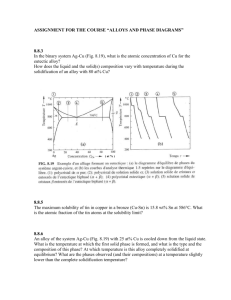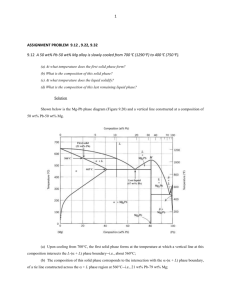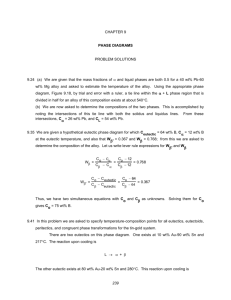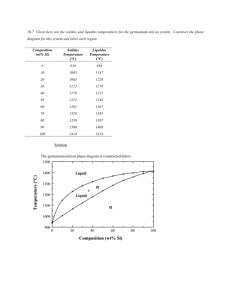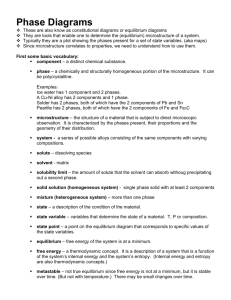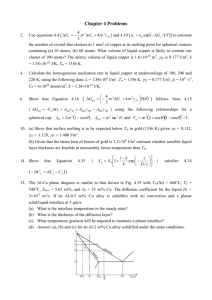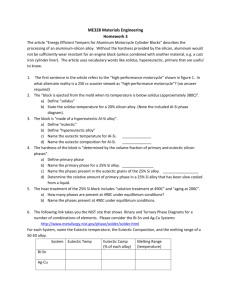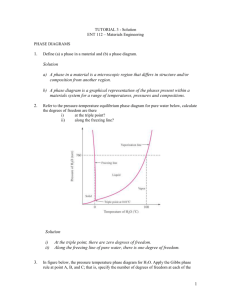Problem 9.13 a. To Find: The phases and the compositions of these
advertisement
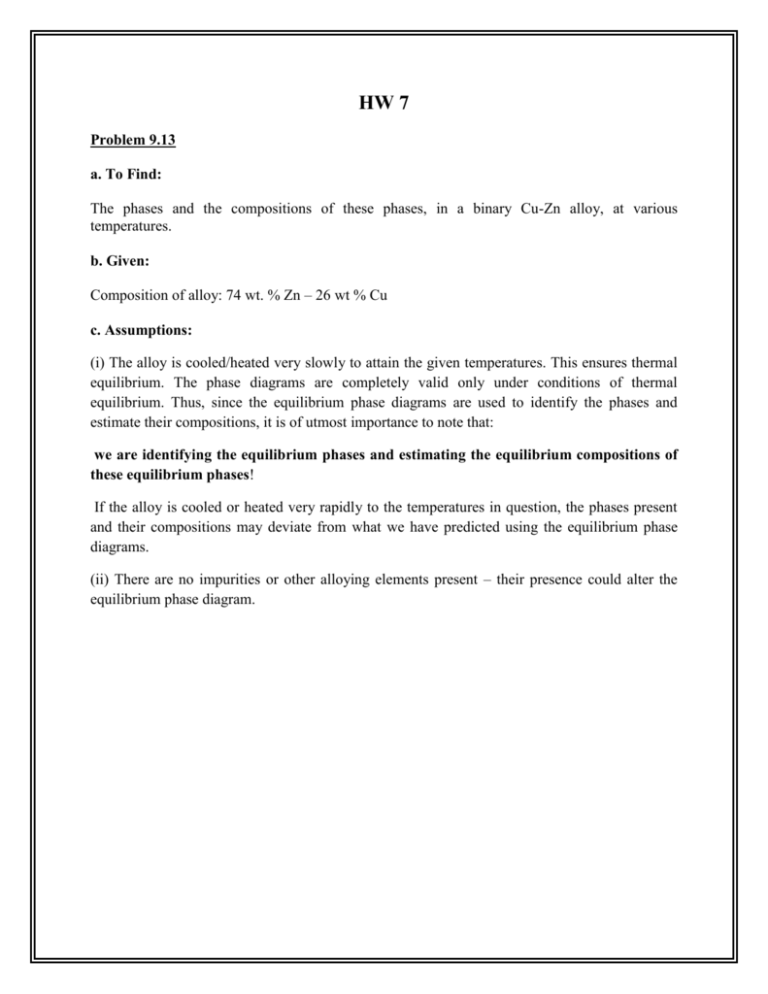
HW 7 Problem 9.13 a. To Find: The phases and the compositions of these phases, in a binary Cu-Zn alloy, at various temperatures. b. Given: Composition of alloy: 74 wt. % Zn – 26 wt % Cu c. Assumptions: (i) The alloy is cooled/heated very slowly to attain the given temperatures. This ensures thermal equilibrium. The phase diagrams are completely valid only under conditions of thermal equilibrium. Thus, since the equilibrium phase diagrams are used to identify the phases and estimate their compositions, it is of utmost importance to note that: we are identifying the equilibrium phases and estimating the equilibrium compositions of these equilibrium phases! If the alloy is cooled or heated very rapidly to the temperatures in question, the phases present and their compositions may deviate from what we have predicted using the equilibrium phase diagrams. (ii) There are no impurities or other alloying elements present – their presence could alter the equilibrium phase diagram. Fig. 1. Cu-Zn phase diagram d. Solution: This problem can be answered based on Fig. 9.19 in the text, the Cu-Zn phase diagram. (i) At 850C, a liquid phase (L) is present. Composition of this single-phase region is shown by CL = 74 wt.% Zn-26 wt.% Cu. in Fig.1. It is sufficient to state the composition of any one component, for e.g., in this case, the liquid phase contains 74 wt. % Zn. This is because the alloy is binary and it is understood that the composition of the other component, here Cu, would be (100 – wt.% Zn) = 100 – 74 = 26 wt. % Zn. (ii) At 750C, and liquid (L) phases are present. The compositions of the phases may be estimated by drawing a tie line in this 2-phase region at 750C (blue-line in Fig.1.). The 2-phase region here is flanked by the single phase region on the left and the single-phase liquid (L) region on the right. Thus, the composition at the point of intersection of the (blue) tie-line with the boundary (of the 2-phase region) on the left gives us the composition of the phase at this temperature. This point is shown as in Fig.1. C = 67 wt.% Zn-33 wt.% Cu The composition at the point of intersection of the (blue) tie-line with the boundary (of the 2-phase region) on the right gives us the composition of the liquid (L) phase at this temperature. This point is shown as CL = 77 wt.% Zn-23 wt.% Cu in Fig.1. (iii) At 680C, and liquid (L) phases are present. The compositions of the two phases are estimated from the red tie-line at this temperature, using the procedure outlined above. Please note that the composition of the phase < 74 wt. % Zn. The red tie-line intersects the sloped/curved phase boundary and not the vertical line we’ve drawn for our convenience. Composition of C = 73 wt.% Zn-27 wt.% Cu Composition of liquid (L): CL = 82 wt.% Zn-18 wt.% Cu (iv) At 600C, the phase is present. The composition of this single phase is C = 74 wt.% Zn-26 wt.% Cu (v) At 500C, and phases are present; The compositions of the two phases are estimated from the green tie-line at this temperature. C = 69 wt.% Zn-31 wt.% Cu; C = 78 wt.% Zn-22 wt% Cu 850°C 750°C liquid (L): CL = 74 wt% Zn-26 wt% Cu and liquid: C = 67 wt% Zn-33 wt% Cu; CL = 77 wt% Zn-23 wt% Cu 680°C and liquid (L): C = 73 wt% Zn-27 wt% Cu; CL = 82 wt% Zn-18 wt% Cu 600°C C = 74 wt.% Zn-26 wt.% Cu 500°C and : C = 69 wt.% Zn-31 wt.% Cu; C = 78 wt.% Zn-22 wt% Cu Problem 9.26 a. To Find: If there is a binary Cu-Ni alloy that meets the given tensile strength and ductility criteria b. Given: Tensile strength ≥ 350 MPa and ductility ≥48% EL c. Assumptions: (i) Sample is not cold-worked (ii) No other element present in alloy (iii) The strength and ductility of the alloy is to be measured at room temperature (since the graphs in Fig. 9.6 a and b are plotted at room-temperature ) d. Solution: Figure 9.6a: The tensile strength of a Cu-Ni alloy > 350 MPa only when the composition of Ni in the binary Cu-Ni alloy varies between 22.5 and 98 wt%. Figure 9.6b, Ductility equals or exceeds 48%EL compositions of less than 8 wt% Ni and greater than 98 wt% Ni. Hence, both criteria can me at a composition of 98 wt% Ni. Yes, Composition: 98wt.%Ni - 2 wt.%Cu Problem 9.32 a. To Find: o (a) Mass fractions of the phases in the alloy: and , at 775 C (b) Mass fraction of primary a and eutectic micro-constituents (c) Mass fraction of eutectic b. Given: Binary alloy; composition – 25wt%Ag-75wt%Cu c. Assumptions: (i) We are asked to estimate the equilibrium compositions of the equilibrium phases, i.e., the system is in thermal equilibrium with its surroundings (ii) There are no impurities or other alloying elements present – their presence could alter the equilibrium phase diagram. d. Solution: Figure 9.7 in the text is the Cu-Ag phase diagram; we need to use this to answer the questions. Fig.2. Cu-Ag phase diagram o (a) At 775 C, there are two phases present – and . The red horizontal line is the tie-line that needs to be considered. (This red line lies just below the line representing eutectic transformation. Hence, the o wt.% of Ag in of and at 775 C may be considered nearly equal to the wt.% of Ag in o of and at 779 C.) C = 8.0 wt% Ag, C = 91.2 wt% Ag, and C0 = 25 wt% Ag .Using the lever-rule: Total mass fraction of : W = C C0 C C = C C 91.2 25 = 0.796 91.2 8.0 25 8.0 0 = = 0.204 Total mass fraction of : W = C C 91.2 8.0 (b) Ceutectic = 71.9 wt.%Ag To evaluate mass fraction of primary and eutectic micro-constituents, we may (I) employ equations 9.11 and 9.10 respectively OR (II) apply the lever rule at a tie-line drawn just above the line representing eutectic transformation. I and II are equivalent. Mass fraction of primary : W ’ = Ceutectic C0 71.9 25 = = 0.734 Ceutectic C 71.9 8.0 If (I) is used - Mass fraction of eutectic micro-constituents: If (II) is used - Mass fraction of liquid, all of which transforms to the eutectic mixture at the eutectic transformation temperature, and hence the mass fraction of eutectic micro-constituents: We = C0 C 25 8.0 = = 0.266 Ceutectic C 71.9 8.0 (c) As we know, the eutectic reaction involves L + Thus, can be part of the eutectic mixture, i.e., it is one of the two eutectic microconstituents. Also, as seen in part b, there’s also some primary in the alloy. Total = Primary + in eutectic mixture in eutectic mixture = Total - Primary W – W' = 0.796 – 0.734 = 0.062 (a) Mass fraction of =0.796 Mass fraction of =0.204 (b) Mass fraction of primary = 0.734 Mass fraction of eutectic micro-constituents = 0.266 (c) Mass fraction of eutectic = 0.062 [Note: It’s ok if some people quote the values in %. E.g. in mixture =79.6% =79.6/100 => mass fraction of =0.796] Problem 9.57 a. To Find: The maximum mass fraction of pro-eutectoid cementite for a hyper-eutectoid iron-carbon alloy b. Given: Alloy is hyper-eutectoid => wt.% C in alloy> wt. %C at eutectoid composition => wt.%C > 0.76 c. Assumptions: (i) The iron-carbon alloy is a steel, i.e., wt.% C ≤2.14 . (ii) No other element is present in the alloy d. Solution: We need to calculate the mass fraction of pro-eutectoid cementite present in various hypereutectoid steels. This means that we need to calculate the mass fraction of pro-eutectoid cementite for alloys where 0.76 < wt.% C ≤2.14. Fig.9.24 in the textbook presents the concerned phase diagram . C0 Figure 9.24 Iron-iron carbide phase diagram (Fig. 9.24 in text) Let the wt.% C in the alloy be C0. Then, the mass fraction of pro-eutectoid cementite can be calculated either (i) using equation 3.11 or (ii) using the tie-line (thick, blue line) just above the line representing eutectoid transformation and applying the lever rule. Mass fraction of pro-eutectoid cementite is (C0 – 0.76) / (6.70 – 0.76) Range of C0 to be considered: 0.76 < C0 ≤ 2.14 It can be seen that the maximum mass fraction of cementite occurs at C0 = 2.14 Mass fraction of cementite at 2.14 wt.% C (i.e. at C0 = 2.14) = (2.14 – 0.76) / (6.70-0.76) = 1.38 / 5.94 = 0.232 The maximum mass fraction of pro-eutectoid cementite possible for a hyper-eutectoid iron-carbon alloy (steel) is 0.232 Problem 9.63 a. To Find: Schematic sketches of micro-structure of given alloy at various temperatures. The phases in the sketches should be labeled and their compositions should be estimated. b. Given: (i) Alloy composition: 5wt% C – 95 wt% Fe c. Assumptions: (i) We are asked to estimate the equilibrium compositions of the equilibrium phases, i.e., the system is in thermal equilibrium with its surroundings (ii) There are no impurities or other alloying elements present – their presence could alter the equilibrium phase diagram. d. Solution: Fig.3. Iron – iron carbide phase diagram, Fig.9.24 in text-book o 1175 C: Phases present – Liquid (L) + Fe3C Compositions of phases (from blue tie-line): Lwt.C), Fe3C (6.67 wt.% C) o 1145 C: Phases present – + Fe3C Compositions of phases (from red tie-line): wt.%C) , Fe3C(6.67 wt.% C) o 700 C: Phases present –+ Fe3C Compositions of phases (from green tie-line): (0.022 wt.% C), Fe3C(6.67 wt.% C) The schematic micro-structures are shown below: The explanation for the above micro-structures is as follows: o At 1175 C, the microstructure consists of a lot of liquid with some chunks of cementite as indicated by the phase diagram. o As the alloys is cooled to 1145 C, the chunks of (pro-eutectic) cementite stay untransformed but all the liquid that was present earlier undergoes a eutectic transformation, i.e, the liquid goes to a mixture of cementite and austenite. This 'new' cementite is present, not as chunks but as plates .Anything other than the pro-eutectic cementite and the 'new' cementite is austenite. o On further cooling to 700 C, the pro-eutectic and 'new' cementite stay as they were but all the austenite undergoes the eutectoid transformation reaction and converts to a eutectoid mixture of ferrite (alpha) and newer cementite. This most recently formed cementite is ALSO in the form of plates, not globules Whatever's not cementite is ferrite.
